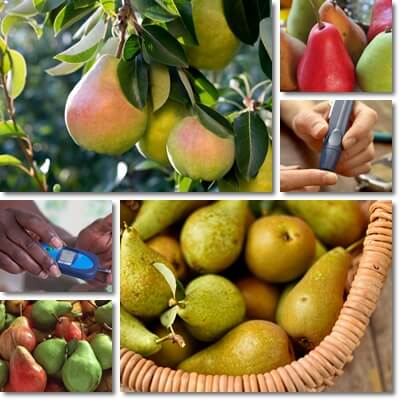Yes, you can, but in limited amounts as part of an overall clean, balanced and varied diet, tailored to the nutritional restrictions imposed by a diabetic diet. Provided intake is moderate and suited to your individual nutritional requirements, pears can actually be good for diabetes and provide minor benefits for weight loss and weight management, skin, nervous system and cardiovascular health, all important aspects of diabetic health. The major benefit of pears for diabetes is their low glycemic index and low glycemic load which makes them a good fruit to eat for balanced blood sugar metabolism.
Eating moderate amounts of pears with diabetes doesn’t raise blood sugar levels too fast too much. However, not all diabetics may eat the same amount of the fruit without side effects. Pears are still an important source of digestible carbohydrates, most of which are naturally occurring sugars, and can and will raise blood sugar levels to unhealthy levels if consumed in large enough amounts. How pears affect blood sugar in diabetes depends mostly on how much of the fruit you eat and how often.

Some diabetics may feel sick after eating even one pear, while others may feel great. In type 2 diabetes, such effects are largely determined by what is known as ‘insulin sensitivity factor’, or how well the hormone insulin produced by the pancreas responds to the sugar in the bloodstream (moving it out of the bloodstream to where it’s needed). The greater the insulin resistance (or the less responsive the hormone insulin is to sugar), the less of certain fruit or the smaller the servings of fruit a diabetic may eat without side effects. In type 1 diabetes, the lower the production of insulin by the pancreas, the lower the tolerance to high amounts of digestible carbohydrates, sugar included.
It’s recommended all diabetics see a doctor or dietitian and get a personalized eating plan that helps them determine how much carbs and sugar they can eat in a day and per meal. This should help them plan meals ahead and include fruits in their diet.
Like is the case with most fruits, the effects of pears for diabetes are primarily determined by the following factors: sugar and total carbohydrate content, glycemic index, glycemic load, energetic value (calories) and other relevant nutritional facts (vitamins, minerals, antioxidants, fats, protein).
Are pears full of sugar?
They kind of are rich in sugar, but so are plenty of other fruits that are generally well tolerated by diabetics. 100 g of raw pears has 15.23 g of total carbohydrates of which 9.75 g are sugars. By comparison, 100 g of sweet cherries have 16 g of total carbohydrates of which 12.82 g are sugars. 100 g of grapes (American and European varieties) have 17-18 g of total carbohydrates of which 15-16 g are sugars. 100 g of apple with skin has 13.8 g of total carbohydrates of which 10.4 g are sugars.

Fortunately, the human body requires carbohydrates as essential, life-sustaining nutrients and sugars are the simplest forms of carbohydrates. So it’s actually good to eat pears and other fruit and plant food with diabetes. But because the diabetic body either doesn’t make enough insulin (type 1 diabetes) or the insulin it makes is not very efficient at doing its job of moving sugar out of the bloodstream (type 2 diabetes), the only rule is to avoid excesses so you don’t overwhelm your body. You can eat fruit, just small amounts so that your body may have a chance at processing the carbs and sugar.
Are pears low glycemic fruit?
Yes, pears are low-glycemic, one of the lowest glycemic fruits actually. The glycemic index (GI) of pears is 38 (low). The glycemic index (GI) is a scale that measures how fast the carbohydrates in plant food raise blood glucose levels, compared to the effects of pure glucose. Below 55 is a low GI. Between 55-69 is a moderate GI. Between 70-100 is a high GI.
Now, all plant foods, pears included, raise blood sugar levels. It’s normal. It’s just the body’s way of making energy from digestible carbohydrates in plant foods. But the lower the GI, the steadier the rise in blood sugar levels and the less likely the fluctuations. So foods with a low GI like pears are actually good for diabetes (in limited amounts) because the digestible carbohydrates in them are absorbed at a steady rate and don’t overwhelm the body. Strawberries (GI: 40) and apples (GI: 39) have similar glycemic indexes and effects.
Pears glycemic load: 4 (low). The glycemic load (GL) is similar to the glycemic index (GI) in the sense that it measures the effects of the carbohydrates in plant foods on blood sugar levels. But instead, the glycemic load takes into account actual serving size of foods which is why it’s thought to be more accurate when determining the effects of fruits and other plant foods for diabetics. Below 10 is a low GL. Between 11-19 is a moderate GL. Over 20 is high. Basically, fruits like pears have minimal effects on blood sugar levels when consumed in moderate amounts and are thus good for blood sugar metabolism.
Benefits of pears for diabetes include:
1) Steadier blood sugar levels thanks to good amounts of dietary fiber, low glycemic index and glycemic load.
2) Minor benefits for weight loss and weight management as a result of good fiber content (3.1 g of dietary fiber/100 g of fruit with skin) and moderately low energetic value (57 kcal/100 g of fruit with skin).
3) Minor wound healing and other skin benefits thanks to small, but varied B vitamins profile and vitamins C and E content.
4) B vitamins for diabetes-associated nerve damage (neuropathy).
5) Low fat (0.14 g of fat/100 g of fruit) and good fiber content for healthier blood cholesterol profile.
6) Minor benefits for hypertension and overall cardiovascular health thanks to small amounts of magnesium, potassium and vitamin C.
While pears nutrition profile is not excellent in any way, the very modest amounts of B vitamins, vitamins C, E and K, calcium, iron, magnesium, manganese, phosphorus, potassium and zinc, good amounts of dietary fiber, almost nonexistent fat content, low energetic value all contribute to nutritional status and are thus active participants to good health. The low glycemic index and glycemic load recommend them for diabetic diets and diabetes prevention.
Pears disadvantages for diabetes only stem from an excessive consumption. Eating too much of the fruit, too often causes an accumulation of digestible carbohydrates and sugar which, in the context of insulin resistance or not enough insulin being produced, renders the body incapable of adequately processing sugar in the bloodstream. Side effects may be short-term such as weakness, tiredness, feelings of unwell or long-term (nerve damage in extremities, vision problems, poor wound healing, heart disease etc.).
Conclusion
Can diabetics eat pears? Yes, they can, just in limited amounts so as to ensure a balanced blood sugar metabolism. Overall, diabetes and pears are a felicitous association and a source of mostly benefits for the condition. It’s important to understand that just because pears are fruit and contain sugar, they shouldn’t be excluded from a diabetic diet. They are actually good for you because they provide small amounts of a a variety of vitamins, minerals and antioxidants as well as good amounts of fiber. Most important, they have a low glycemic index (39) and glycemic load (4) so they don’t raise blood sugar levels excessively. But like most fruit, they are best consumed in moderation. The limit to how much pears you can eat with diabetes is best set by your doctor or a dietitian, based on your individual nutritional requirements and the specifics of your condition.
